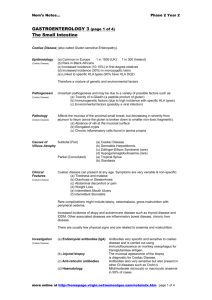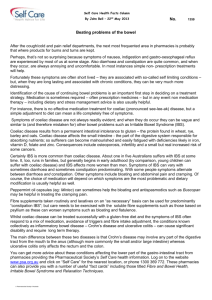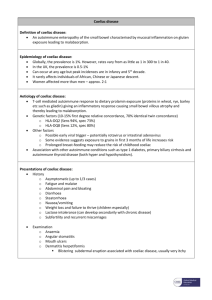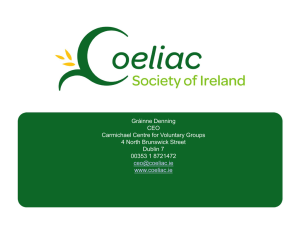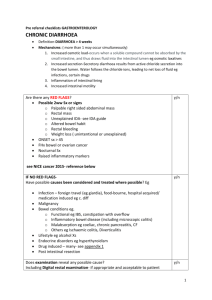Coeliac crisis with severe hypokalaemia in an adult Rosalie Magro, Edgar Pullicino
advertisement
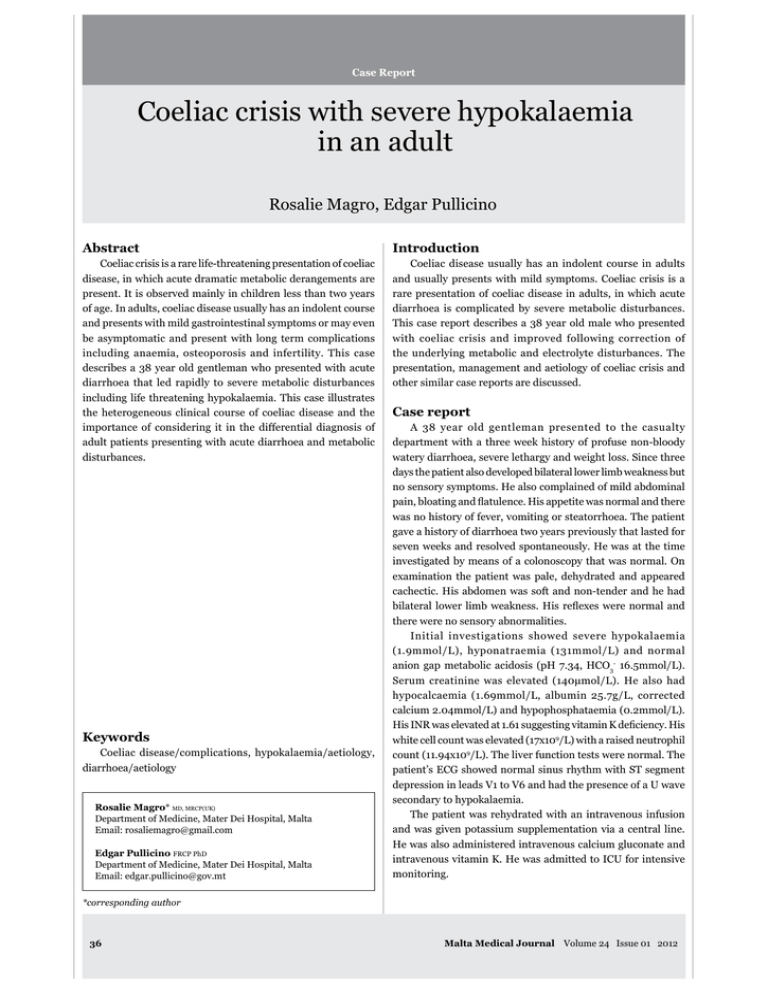
Coeliac crisis with severe hypokalaemia in an adult Rosalie Magro, Edgar Pullicino Coeliac crisis is a rare life-threatening presentation of coeliac disease, in which acute dramatic metabolic derangements are present. It is observed mainly in children less than two years of age. In adults, coeliac disease usually has an indolent course and presents with mild gastrointestinal symptoms or may even be asymptomatic and present with long term complications Coeliac disease usually has an indolent course in adults and usually presents with mild symptoms. Coeliac crisis is a rare presentation of coeliac disease in adults, in which acute diarrhoea is complicated by severe metabolic disturbances. describes a 38 year old gentleman who presented with acute diarrhoea that led rapidly to severe metabolic disturbances presentation, management and aetiology of coeliac crisis and other similar case reports are discussed. the heterogeneous clinical course of coeliac disease and the importance of considering it in the differential diagnosis of adult patients presenting with acute diarrhoea and metabolic disturbances. with coeliac crisis and improved following correction of A 38 year old gentleman presented to the casualty department with a three week history of profuse non-bloody watery diarrhoea, severe lethargy and weight loss. Since three days the patient also developed bilateral lower limb weakness but no sensory symptoms. He also complained of mild abdominal gave a history of diarrhoea two years previously that lasted for seven weeks and resolved spontaneously. He was at the time investigated by means of a colonoscopy that was normal. On examination the patient was pale, dehydrated and appeared cachectic. His abdomen was soft and non-tender and he had there were no sensory abnormalities. Initial investigations showed severe hypokalaemia (1.9mmol/L), hyponatraemia (131mmol/L) and normal anion gap metabolic acidosis (pH 7.34, HCO3- 16.5mmol/L). hypocalcaemia (1.69mmol/L, albumin 25.7g/L, corrected calcium 2.04mmol/L) and hypophosphataemia (0.2mmol/L). Coeliac disease/complications, hypokalaemia/aetiology, diarrhoea/aetiology * MD, MRCP(UK) Department of Medicine, Mater Dei Hospital, Malta Email: rosaliemagro@gmail.com Edgar Pullicino FRCP PhD Department of Medicine, Mater Dei Hospital, Malta Email: edgar.pullicino@gov.mt white cell count was elevated (17x109/L) with a raised neutrophil count (11.94x109 depression in leads V1 to V6 and had the presence of a U wave secondary to hypokalaemia. and was given potassium supplementation via a central line. He was also administered intravenous calcium gluconate and intravenous vitamin K. He was admitted to ICU for intensive monitoring. *corresponding author 36 Malta Medical Journal Volume 24 Issue 01 2012 Further investigations included stool culture and sensitivity, stool examination for ova, cysts and parasites and Clostridium and hypoproteinaemic (39.2g/L). Haematinics revealed vitamin B12 respectively) despite a normal haemoglobin at presentation haemoconcentration since the haemoglobin dropped to 10.8g/ dL with rehydration. Once the dehydration and electrolyte depletion were resolved completely and he was transferred from ICU after two days. Coeliac disease was suspected as anti-endomysial antibody IgA was positive and tissue transglutaminase IgA and IgG were elevated (35.9U/ml and 20.6U/ml respectively). disease, Marsh-Oberhuber type 3c as duodenal biopsies showed complete loss of duodenal villi and marked intraepithelial congestion, increased number of lymphocytes, histiocytes and eosinophils in the lamina propria. B12 injections were given intramuscularly. He was prescribed multivitamins and calcium supplements. A bone density nine days. After four months the patient remained well and was completely asymptomatic. He had gained adequate weight. Coeliac disease is an immune-mediated enteropathy characterised by malabsorption and villous atrophy triggered by gluten-containing grains (including wheat, rye and barley) in to 10 percent of cases.1 Adult coeliac disease, in contrast to its childhood counterpart, almost always has an indolent course with a wider spectrum of clinical manifestations. Approximately half of the patients have no overt gastrointestinal symptoms and many are term complications including anaemia, osteoporosis, infertility and gastrointestinal cancer. Other individuals have symptoms of mild bloating and diarrhoea, and few patients present with 2 One rare presentation of coeliac disease is the ‘coeliac crisis’. disease, most frequently seen in paediatric patients less than two years of age and has rarely been described in adults. Clinically, it is characterized by severe diarrhoea, dehydration, and metabolic include metabolic acidosis, hypokalaemia, hyponatraemia, Malta Medical Journal Volume 24 Issue 01 2012 hypocalcaemia, hypomagnesaemia, and hypoproteinaemia. Coeliac crisis is associated with a high morbidity rate, mandating been reported in the literature and for this reason coeliac disease is rarely considered in adults presenting with acute severe diarrhoeal illness, even when infectious aetiologies have been excluded.3-10 Of the twenty cases, 15 were women and 5 were men, the mean age at diagnosis was 51.4 years overall; 73.4 years in men and 46.6 years in women. All patients described presented with severe diarrhoea. Other symptoms and signs included vomiting, dehydration, hypotension, peripheral neuropathy and tetany secondary to hypocalcaemia. A rare presentation is limb weakness secondary have described but has also been reported in two other cases.5,8 Metabolic and electrolyte disturbances that have been reported include renal dysfunction presenting as increased creatinine level, metabolic acidosis, hypokalaemia, hypocalcaemia, hyponatraemia, hypomagnesaemia and hypoalbuminaemia. most severe reported hypokalaemia in coeliac crisis. Another rare presentation is bleeding diathesis secondary to prolonged prothrombin time.9 In our case the patient had a prolonged INR but there was no evidence of bleeding. All reported patients required hospitalization, intravenous and they were all started on a gluten-free diet. Few patients required parenteral nutrition and corticosteroids. In the majority of patients symptoms resolved with supportive care and a gluten-free diet alone. crisis whereas the vast majority of patients with coeliac disease run a milder course is unclear. In some of the reported cases, coeliac crisis appears to be precipitated by a general immune stimulus such as pregnancy, surgery and infection.4,10 In most of the reported cases, including our case, no precipitating factor was present. It is unclear whether coeliac crisis in adults occurs at disease onset or whether coeliac disease is present but of the reported cases of coeliac crisis occurred in individuals who had already been diagnosed with coeliac disease but had not been following a gluten-free diet.4,9 adult cases, the patients presented with relatively acute onset watery diarrhoea, although chronic symptoms have also been present in some cases.3,8 patient described a seven week history of diarrhoea that occurred two years prior to presentation with coeliac crisis. support with correction of the underlying metabolic and electrolyte disturbances. Most of the reported cases including our case responded quickly to these interventions alone. For 37 individuals not responding promptly to gluten restriction, treatment involves the use of steroids, which are weaned off over a period of few months.11 it should be considered in the differential diagnosis of all patients presenting with an acute onset of severe diarrhoea with metabolic disturbances. Any patient found to have an increased tissue transglutaminase IgA in this setting should be placed on a gluten-free diet and have a small intestinal biopsy performed as soon as possible. Corticosteroids should be considered in cases and electrolyte repletion, does not result in rapid improvement. Nutritional support often is required in the short term but most patients ultimately respond to gluten avoidance. Acknowledgement Dr D. Babic, Histopathologist, Department of Pathology, Mater Dei Hospital, Malta for the interpretation of the histology. 1. Fasano A. Celiac Disease - How to Handle a Clinical Chameleon. N Engl J Med. 2003 Jun 348(25):2568570. 2. Rostom A, Murray JA, Kagnoff MF. American Gastroenterological Association (AGA) Institute technical review on the diagnosis and management of celiac disease, Gastroenterology. 2006 Dec 131(6):1981–2002. 3. of two cases. Eur J Emerg Med. 2004 Dec 11(6):36365. 4. Sheth S et al. CeliaccCrisisiIs arRare butsSeriouscComplication ofcCeliacdDisease inaAdults. Clin Gastroenterol Hepatol. 2010 Ju; 8(7):58-590. 5. paralysis in a young lady. Indian J Gastroentero. 2006 Sep-Oc; 25(5):25-260. 6. Wolf I, Mouallem M, Farfel Z. Adult celiac disease presented with celiac crisis: severe diarrhea, hypokalemia, and acidosis. J Clin Gastroenterol. 200 Apr; 30(3):32326. 7. Al Shammeri O, Duerksen DR. Celiac crisis in an adult on immunosuppressive therap., Can J Gastroenterol. 2008 Ju; 22(6):57576. 8. Atikou A, Rabhi M, Hidani H. Coeliac crisis with quadriplegia due to potassium depletion as presenting feature of coeliac disease. Rev Med Interne. 2009 Jun; 30(6):51518. 9. bleeding diathesis. Acta Gastroenterol Latinoam. 2009 Ma; 39(1):5-54. 10. Kelly E, Cullen G, Aftab AR, Courtney G. Coeliac crisis presenting with cytomegalovirus hepatitis. Eur J Gastroenterol Hepatol. 2006 Ju; 18(7):79795. 11. celiac crisis. J Pediatr. 1972 De; 81(6):1071081. Senior Clinical Fellow: Emergency Medicine Interested in living and working in London for a year, or more? Emergency Medicine? Keen on gaining the best training to pass the MCEM? We are looking for doctors with at least 2 years postgraduate experience in acute specialities of which at least 6 months in Emergency Medicine, to work and train as a Senior Clinical Fellows in the Emergency Department of Queen Elizabeth Hospital, Woolwich in London. The hospital is located in the heart of historic South East London. Successful candidates will join a dynamic emergency workforce treating a wide spectrum of 38 emergency medicine presentations. This is a great opportunity to broaden your experience while working in a very friendly and supportive environment. The post holders will work up to 48 hours per week (including night shifts and weekend duties). There are 3-4 night-shifts per month. Accommodation may be available. There is a strong training culture with protected four hours of training per week, incorporating lecture-room teaching and clinical supervision, attendance at relevant clinics and courses, and full immersion simulation sessions. Special focus is given towards passing the College of Emergency Medicine examinations. For more details please contact Mr Ferdinand Ohanusi (Consultant in Emergency Department) on +44 208 fohanusi@nhs.net or Mr Hayder Hassan (Consultant in Emergency Medicine) on +44 hayder.hassan@ nhs.net. There are also opportunities progression to a more senior grade. A more detailed description of these posts and information on how to apply is available by visiting our website . Closing date: 30 September 2012 Malta Medical Journal Volume 24 Issue 01 2012
